Analyzing School Performance: A Report on Warra State School
VerifiedAdded on 2023/06/13
|11
|2474
|144
Report
AI Summary
This report assesses the performance of Warra State School based on student progress, goal setting, and school standards. It focuses on student-centered planning, expectations, curriculum alignment, safe learning environments, and evidence-based decision-making. The assessment correlates school effectiveness with competitors, analyzes student satisfaction, incorporates intervention programs, and measures cost efficiency. The school uses online assessments and digital technologies to promote student independence and implements summative, diagnostic, and formative assessments. Expectations include attaining regional standards, providing quality bookwork, and gathering feedback from various sources. The curriculum aligns with assessment through direct instruction and creative learning, with digital technology integrated for skill development. A safe learning environment is fostered through student-teacher relationships and clear communication. The report also highlights the benefits of talented teachers, focused coaching, and additional resources for students. Performance indicators, including efficiency, service, and effectiveness, are used to enhance school performance.
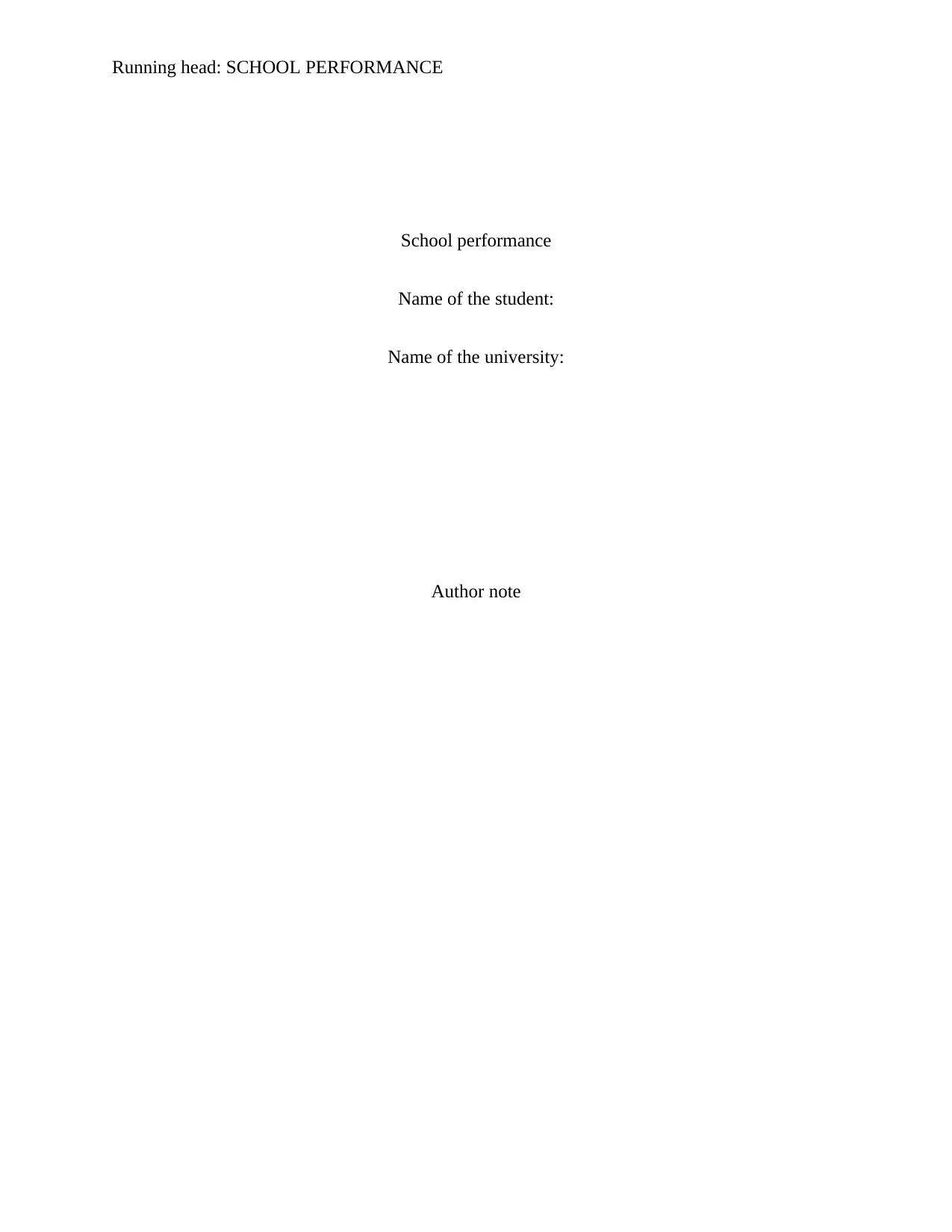
Running head: SCHOOL PERFORMANCE
School performance
Name of the student:
Name of the university:
Author note
School performance
Name of the student:
Name of the university:
Author note
Paraphrase This Document
Need a fresh take? Get an instant paraphrase of this document with our AI Paraphraser
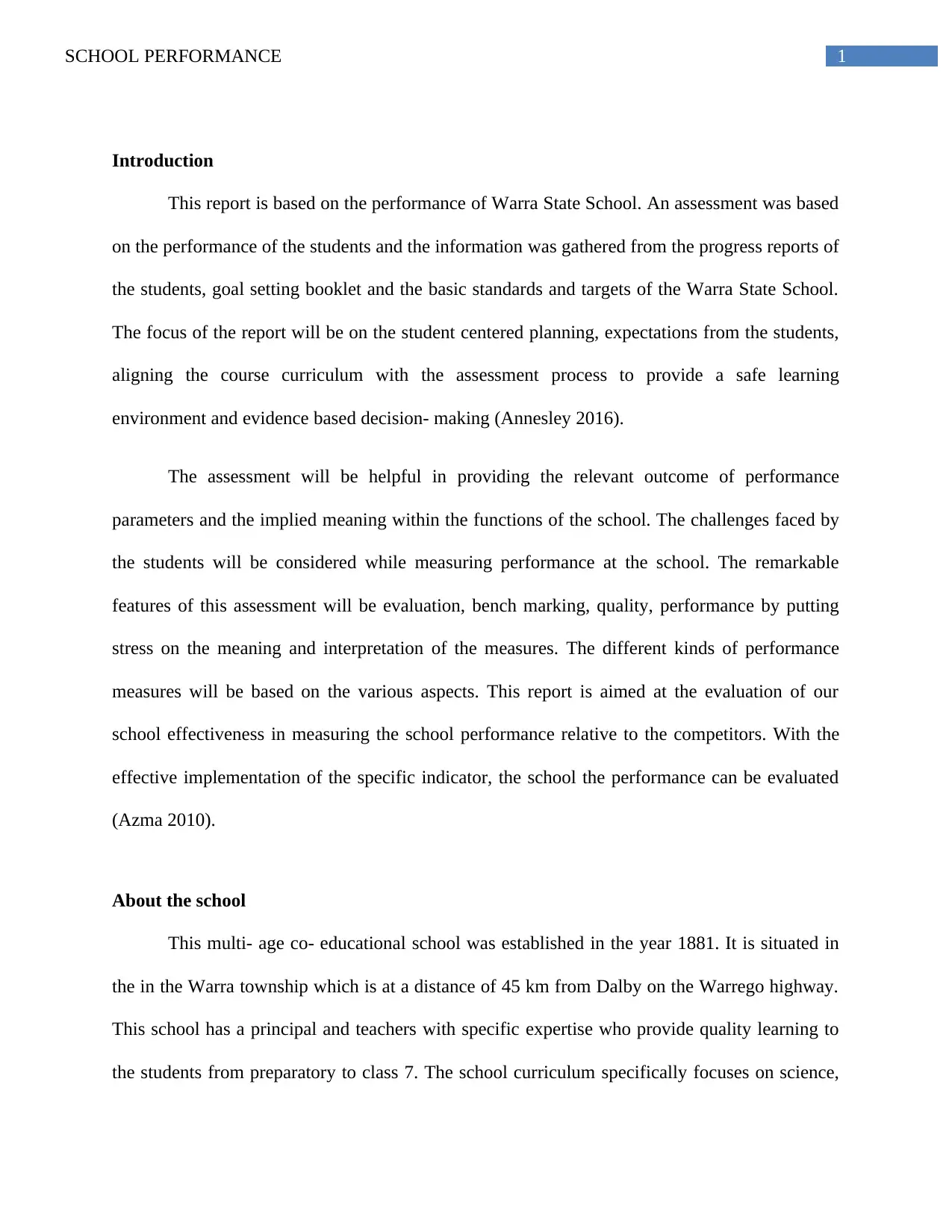
1SCHOOL PERFORMANCE
Introduction
This report is based on the performance of Warra State School. An assessment was based
on the performance of the students and the information was gathered from the progress reports of
the students, goal setting booklet and the basic standards and targets of the Warra State School.
The focus of the report will be on the student centered planning, expectations from the students,
aligning the course curriculum with the assessment process to provide a safe learning
environment and evidence based decision- making (Annesley 2016).
The assessment will be helpful in providing the relevant outcome of performance
parameters and the implied meaning within the functions of the school. The challenges faced by
the students will be considered while measuring performance at the school. The remarkable
features of this assessment will be evaluation, bench marking, quality, performance by putting
stress on the meaning and interpretation of the measures. The different kinds of performance
measures will be based on the various aspects. This report is aimed at the evaluation of our
school effectiveness in measuring the school performance relative to the competitors. With the
effective implementation of the specific indicator, the school the performance can be evaluated
(Azma 2010).
About the school
This multi- age co- educational school was established in the year 1881. It is situated in
the in the Warra township which is at a distance of 45 km from Dalby on the Warrego highway.
This school has a principal and teachers with specific expertise who provide quality learning to
the students from preparatory to class 7. The school curriculum specifically focuses on science,
Introduction
This report is based on the performance of Warra State School. An assessment was based
on the performance of the students and the information was gathered from the progress reports of
the students, goal setting booklet and the basic standards and targets of the Warra State School.
The focus of the report will be on the student centered planning, expectations from the students,
aligning the course curriculum with the assessment process to provide a safe learning
environment and evidence based decision- making (Annesley 2016).
The assessment will be helpful in providing the relevant outcome of performance
parameters and the implied meaning within the functions of the school. The challenges faced by
the students will be considered while measuring performance at the school. The remarkable
features of this assessment will be evaluation, bench marking, quality, performance by putting
stress on the meaning and interpretation of the measures. The different kinds of performance
measures will be based on the various aspects. This report is aimed at the evaluation of our
school effectiveness in measuring the school performance relative to the competitors. With the
effective implementation of the specific indicator, the school the performance can be evaluated
(Azma 2010).
About the school
This multi- age co- educational school was established in the year 1881. It is situated in
the in the Warra township which is at a distance of 45 km from Dalby on the Warrego highway.
This school has a principal and teachers with specific expertise who provide quality learning to
the students from preparatory to class 7. The school curriculum specifically focuses on science,
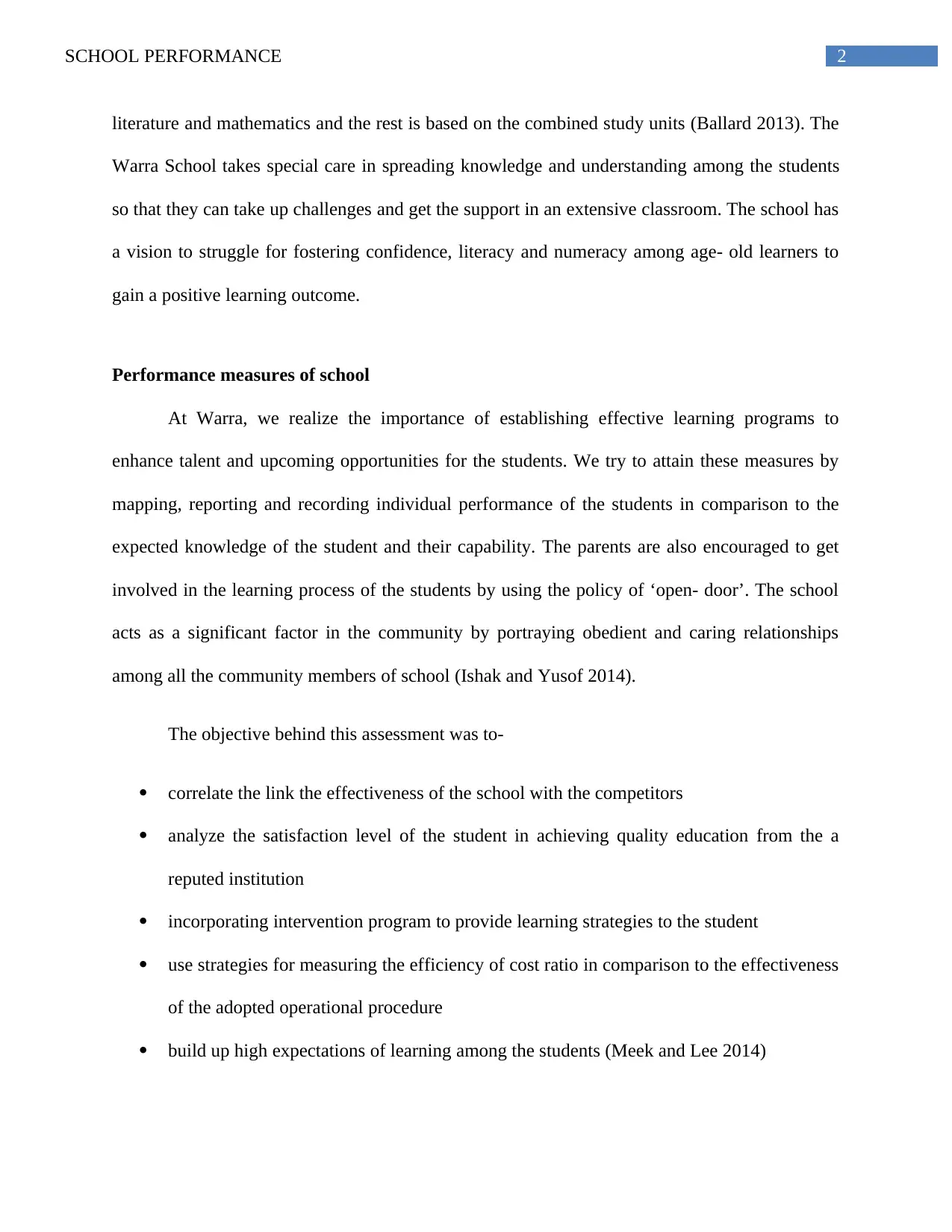
2SCHOOL PERFORMANCE
literature and mathematics and the rest is based on the combined study units (Ballard 2013). The
Warra School takes special care in spreading knowledge and understanding among the students
so that they can take up challenges and get the support in an extensive classroom. The school has
a vision to struggle for fostering confidence, literacy and numeracy among age- old learners to
gain a positive learning outcome.
Performance measures of school
At Warra, we realize the importance of establishing effective learning programs to
enhance talent and upcoming opportunities for the students. We try to attain these measures by
mapping, reporting and recording individual performance of the students in comparison to the
expected knowledge of the student and their capability. The parents are also encouraged to get
involved in the learning process of the students by using the policy of ‘open- door’. The school
acts as a significant factor in the community by portraying obedient and caring relationships
among all the community members of school (Ishak and Yusof 2014).
The objective behind this assessment was to-
correlate the link the effectiveness of the school with the competitors
analyze the satisfaction level of the student in achieving quality education from the a
reputed institution
incorporating intervention program to provide learning strategies to the student
use strategies for measuring the efficiency of cost ratio in comparison to the effectiveness
of the adopted operational procedure
build up high expectations of learning among the students (Meek and Lee 2014)
literature and mathematics and the rest is based on the combined study units (Ballard 2013). The
Warra School takes special care in spreading knowledge and understanding among the students
so that they can take up challenges and get the support in an extensive classroom. The school has
a vision to struggle for fostering confidence, literacy and numeracy among age- old learners to
gain a positive learning outcome.
Performance measures of school
At Warra, we realize the importance of establishing effective learning programs to
enhance talent and upcoming opportunities for the students. We try to attain these measures by
mapping, reporting and recording individual performance of the students in comparison to the
expected knowledge of the student and their capability. The parents are also encouraged to get
involved in the learning process of the students by using the policy of ‘open- door’. The school
acts as a significant factor in the community by portraying obedient and caring relationships
among all the community members of school (Ishak and Yusof 2014).
The objective behind this assessment was to-
correlate the link the effectiveness of the school with the competitors
analyze the satisfaction level of the student in achieving quality education from the a
reputed institution
incorporating intervention program to provide learning strategies to the student
use strategies for measuring the efficiency of cost ratio in comparison to the effectiveness
of the adopted operational procedure
build up high expectations of learning among the students (Meek and Lee 2014)
⊘ This is a preview!⊘
Do you want full access?
Subscribe today to unlock all pages.

Trusted by 1+ million students worldwide
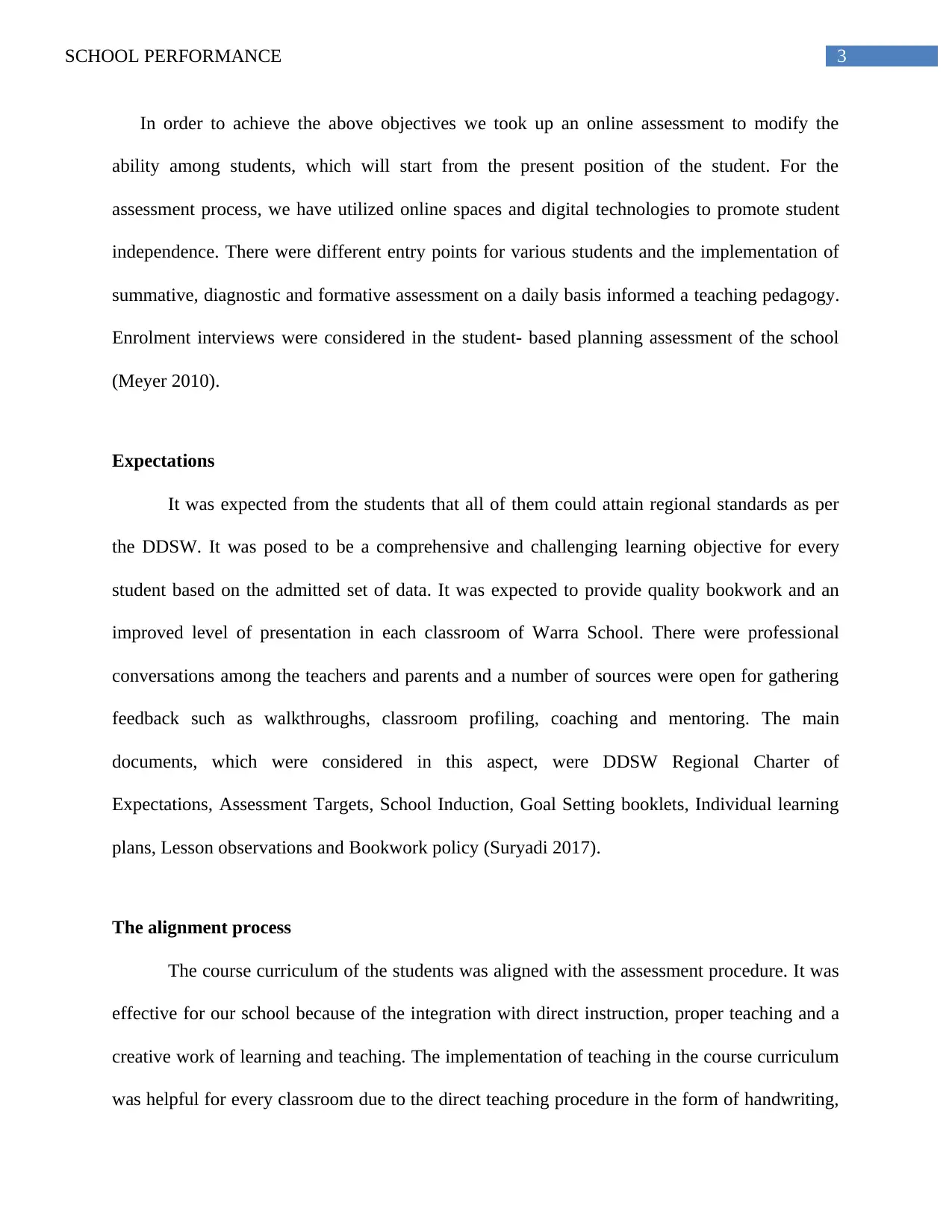
3SCHOOL PERFORMANCE
In order to achieve the above objectives we took up an online assessment to modify the
ability among students, which will start from the present position of the student. For the
assessment process, we have utilized online spaces and digital technologies to promote student
independence. There were different entry points for various students and the implementation of
summative, diagnostic and formative assessment on a daily basis informed a teaching pedagogy.
Enrolment interviews were considered in the student- based planning assessment of the school
(Meyer 2010).
Expectations
It was expected from the students that all of them could attain regional standards as per
the DDSW. It was posed to be a comprehensive and challenging learning objective for every
student based on the admitted set of data. It was expected to provide quality bookwork and an
improved level of presentation in each classroom of Warra School. There were professional
conversations among the teachers and parents and a number of sources were open for gathering
feedback such as walkthroughs, classroom profiling, coaching and mentoring. The main
documents, which were considered in this aspect, were DDSW Regional Charter of
Expectations, Assessment Targets, School Induction, Goal Setting booklets, Individual learning
plans, Lesson observations and Bookwork policy (Suryadi 2017).
The alignment process
The course curriculum of the students was aligned with the assessment procedure. It was
effective for our school because of the integration with direct instruction, proper teaching and a
creative work of learning and teaching. The implementation of teaching in the course curriculum
was helpful for every classroom due to the direct teaching procedure in the form of handwriting,
In order to achieve the above objectives we took up an online assessment to modify the
ability among students, which will start from the present position of the student. For the
assessment process, we have utilized online spaces and digital technologies to promote student
independence. There were different entry points for various students and the implementation of
summative, diagnostic and formative assessment on a daily basis informed a teaching pedagogy.
Enrolment interviews were considered in the student- based planning assessment of the school
(Meyer 2010).
Expectations
It was expected from the students that all of them could attain regional standards as per
the DDSW. It was posed to be a comprehensive and challenging learning objective for every
student based on the admitted set of data. It was expected to provide quality bookwork and an
improved level of presentation in each classroom of Warra School. There were professional
conversations among the teachers and parents and a number of sources were open for gathering
feedback such as walkthroughs, classroom profiling, coaching and mentoring. The main
documents, which were considered in this aspect, were DDSW Regional Charter of
Expectations, Assessment Targets, School Induction, Goal Setting booklets, Individual learning
plans, Lesson observations and Bookwork policy (Suryadi 2017).
The alignment process
The course curriculum of the students was aligned with the assessment procedure. It was
effective for our school because of the integration with direct instruction, proper teaching and a
creative work of learning and teaching. The implementation of teaching in the course curriculum
was helpful for every classroom due to the direct teaching procedure in the form of handwriting,
Paraphrase This Document
Need a fresh take? Get an instant paraphrase of this document with our AI Paraphraser
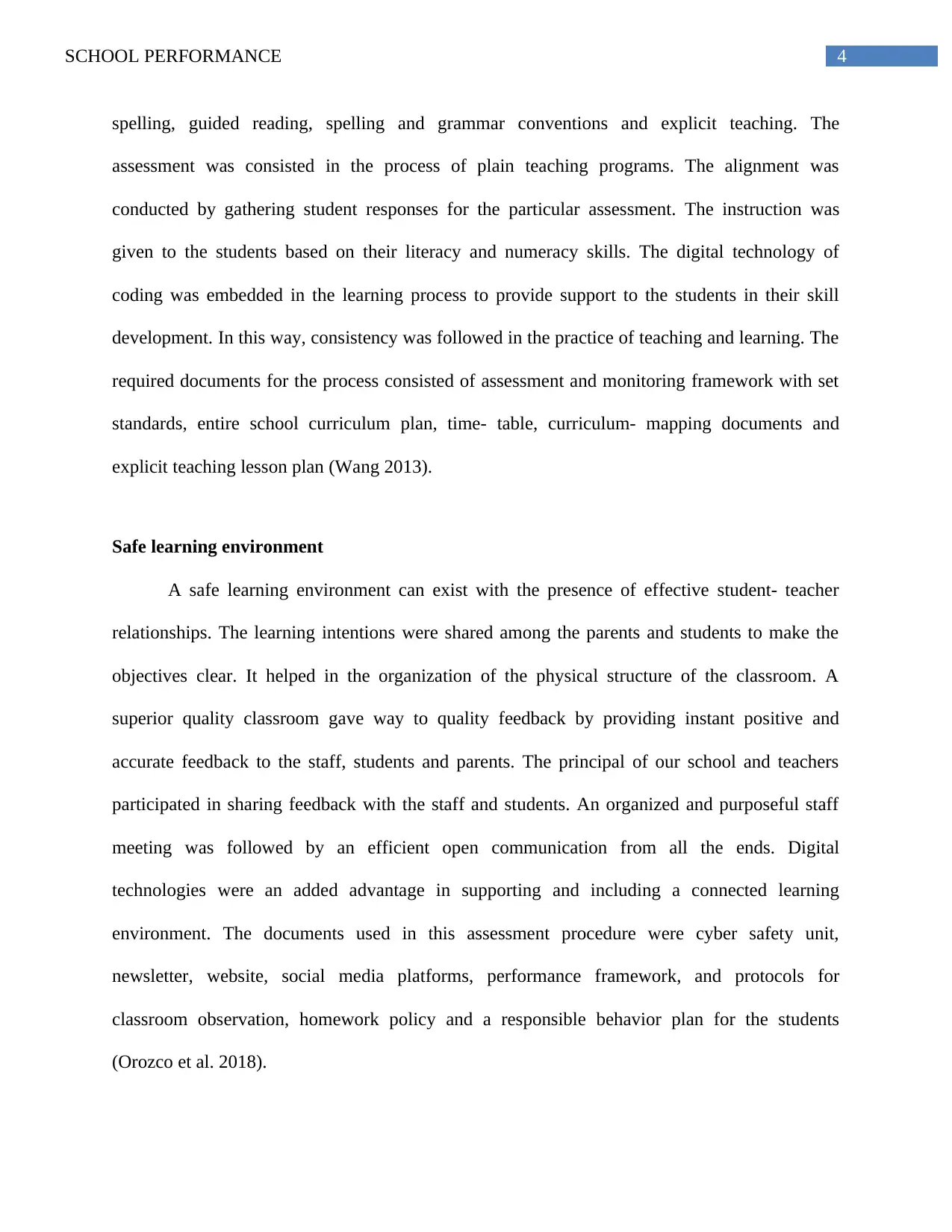
4SCHOOL PERFORMANCE
spelling, guided reading, spelling and grammar conventions and explicit teaching. The
assessment was consisted in the process of plain teaching programs. The alignment was
conducted by gathering student responses for the particular assessment. The instruction was
given to the students based on their literacy and numeracy skills. The digital technology of
coding was embedded in the learning process to provide support to the students in their skill
development. In this way, consistency was followed in the practice of teaching and learning. The
required documents for the process consisted of assessment and monitoring framework with set
standards, entire school curriculum plan, time- table, curriculum- mapping documents and
explicit teaching lesson plan (Wang 2013).
Safe learning environment
A safe learning environment can exist with the presence of effective student- teacher
relationships. The learning intentions were shared among the parents and students to make the
objectives clear. It helped in the organization of the physical structure of the classroom. A
superior quality classroom gave way to quality feedback by providing instant positive and
accurate feedback to the staff, students and parents. The principal of our school and teachers
participated in sharing feedback with the staff and students. An organized and purposeful staff
meeting was followed by an efficient open communication from all the ends. Digital
technologies were an added advantage in supporting and including a connected learning
environment. The documents used in this assessment procedure were cyber safety unit,
newsletter, website, social media platforms, performance framework, and protocols for
classroom observation, homework policy and a responsible behavior plan for the students
(Orozco et al. 2018).
spelling, guided reading, spelling and grammar conventions and explicit teaching. The
assessment was consisted in the process of plain teaching programs. The alignment was
conducted by gathering student responses for the particular assessment. The instruction was
given to the students based on their literacy and numeracy skills. The digital technology of
coding was embedded in the learning process to provide support to the students in their skill
development. In this way, consistency was followed in the practice of teaching and learning. The
required documents for the process consisted of assessment and monitoring framework with set
standards, entire school curriculum plan, time- table, curriculum- mapping documents and
explicit teaching lesson plan (Wang 2013).
Safe learning environment
A safe learning environment can exist with the presence of effective student- teacher
relationships. The learning intentions were shared among the parents and students to make the
objectives clear. It helped in the organization of the physical structure of the classroom. A
superior quality classroom gave way to quality feedback by providing instant positive and
accurate feedback to the staff, students and parents. The principal of our school and teachers
participated in sharing feedback with the staff and students. An organized and purposeful staff
meeting was followed by an efficient open communication from all the ends. Digital
technologies were an added advantage in supporting and including a connected learning
environment. The documents used in this assessment procedure were cyber safety unit,
newsletter, website, social media platforms, performance framework, and protocols for
classroom observation, homework policy and a responsible behavior plan for the students
(Orozco et al. 2018).

5SCHOOL PERFORMANCE
Targeted instructions
It was required to supervise the learning procedure and make use of the feedback on the
student to inform about teaching and learning. The students were encouraged to involve in
practice and excavate their understanding of new knowledge. In order to do so, content and
strategy were provided with a prescribed state of materials. A compact set of reading were
provided at the beginning of each lesson to emphasize on structure, expectations and classroom
routines. In this respect, the differentiation in teaching was referred to as the adjustable entry
point for instruction. The primary documents required for this process were Disability Standards
for Education 2005, reference to Archer and Hughes 16 elements and EAP educational
adjustment program, if required (Parmenter 2015).
Evidence- based decision- making
The assessment at our school took care of the decision based on the knowledge gained by
students, their previous learning and the performance data. It was important to know the present
situation of the student. The data was collected on a regular basis about student performance to
guide them accordingly. The students were placed in the specific groups according to their
ability. Our school used the student data to enhance their performance at school with updated
feedback practices among all the stakeholders. The process of quality planning was conducted
using 1 School 1 Plan to collect the evidence from the student about their achievement as per the
standard benchmark. The decision was then tested by the teachers and staff to focus on the
research procedure. It was done because the students lack in progress without the implementation
of their fundamental skills. This assessment procedure was a reflection of our caring for the
individuals to provide superior quality teaching and learning and establish a healthy relationship
so that they can enjoy their work and learning (Robers 2015).
Targeted instructions
It was required to supervise the learning procedure and make use of the feedback on the
student to inform about teaching and learning. The students were encouraged to involve in
practice and excavate their understanding of new knowledge. In order to do so, content and
strategy were provided with a prescribed state of materials. A compact set of reading were
provided at the beginning of each lesson to emphasize on structure, expectations and classroom
routines. In this respect, the differentiation in teaching was referred to as the adjustable entry
point for instruction. The primary documents required for this process were Disability Standards
for Education 2005, reference to Archer and Hughes 16 elements and EAP educational
adjustment program, if required (Parmenter 2015).
Evidence- based decision- making
The assessment at our school took care of the decision based on the knowledge gained by
students, their previous learning and the performance data. It was important to know the present
situation of the student. The data was collected on a regular basis about student performance to
guide them accordingly. The students were placed in the specific groups according to their
ability. Our school used the student data to enhance their performance at school with updated
feedback practices among all the stakeholders. The process of quality planning was conducted
using 1 School 1 Plan to collect the evidence from the student about their achievement as per the
standard benchmark. The decision was then tested by the teachers and staff to focus on the
research procedure. It was done because the students lack in progress without the implementation
of their fundamental skills. This assessment procedure was a reflection of our caring for the
individuals to provide superior quality teaching and learning and establish a healthy relationship
so that they can enjoy their work and learning (Robers 2015).
⊘ This is a preview!⊘
Do you want full access?
Subscribe today to unlock all pages.

Trusted by 1+ million students worldwide

6SCHOOL PERFORMANCE
Benefits of Warra School
Behind measuring the performance measure, our school has intended to provide talented
teachers and administrators. The school staff section during 2017 displayed that there is only one
efficient full- time staff so it is required to recruit more teachers that are skilled. The strategies
that were implemented for this process included the benefits of a focused and intensive coaching
among the students. We intended to provide a provide teacher aide time to the students so that
additional time is allocated for literacy and numeracy. The goal also included purchasing and
sourcing of proper resources to support those students who experience a tough time in learning.
Our school has allocated 14S funding to support students who want to participate in impact
projects such as writing, thinking, numeracy and reading (Carson et al. 2016).
Three dominant performance indicators were used in the form of efficiency indicators,
service indicators and effectiveness indicators. As per the approach based on research, efficiency
indicators include elementary education and cost per student full- time equivalent, Service
indicators refer to the student attendance from preparatory to class 7. Effectiveness indicators
referred to the assessment of several years from 3 to 9 and their skills in reading writing
conventions of language such as spelling grammar and punctuation and numeracy. The goal-
based approach of our school considered effectiveness measures as per the desired outcome. The
following table has clearly depicted the performance indicators used at the Warra State School.
The performance indicators are categorized as per the activities with relevant description (Chaput
et al. 2016).
Effectiveness indicators
Benefits of Warra School
Behind measuring the performance measure, our school has intended to provide talented
teachers and administrators. The school staff section during 2017 displayed that there is only one
efficient full- time staff so it is required to recruit more teachers that are skilled. The strategies
that were implemented for this process included the benefits of a focused and intensive coaching
among the students. We intended to provide a provide teacher aide time to the students so that
additional time is allocated for literacy and numeracy. The goal also included purchasing and
sourcing of proper resources to support those students who experience a tough time in learning.
Our school has allocated 14S funding to support students who want to participate in impact
projects such as writing, thinking, numeracy and reading (Carson et al. 2016).
Three dominant performance indicators were used in the form of efficiency indicators,
service indicators and effectiveness indicators. As per the approach based on research, efficiency
indicators include elementary education and cost per student full- time equivalent, Service
indicators refer to the student attendance from preparatory to class 7. Effectiveness indicators
referred to the assessment of several years from 3 to 9 and their skills in reading writing
conventions of language such as spelling grammar and punctuation and numeracy. The goal-
based approach of our school considered effectiveness measures as per the desired outcome. The
following table has clearly depicted the performance indicators used at the Warra State School.
The performance indicators are categorized as per the activities with relevant description (Chaput
et al. 2016).
Effectiveness indicators
Paraphrase This Document
Need a fresh take? Get an instant paraphrase of this document with our AI Paraphraser
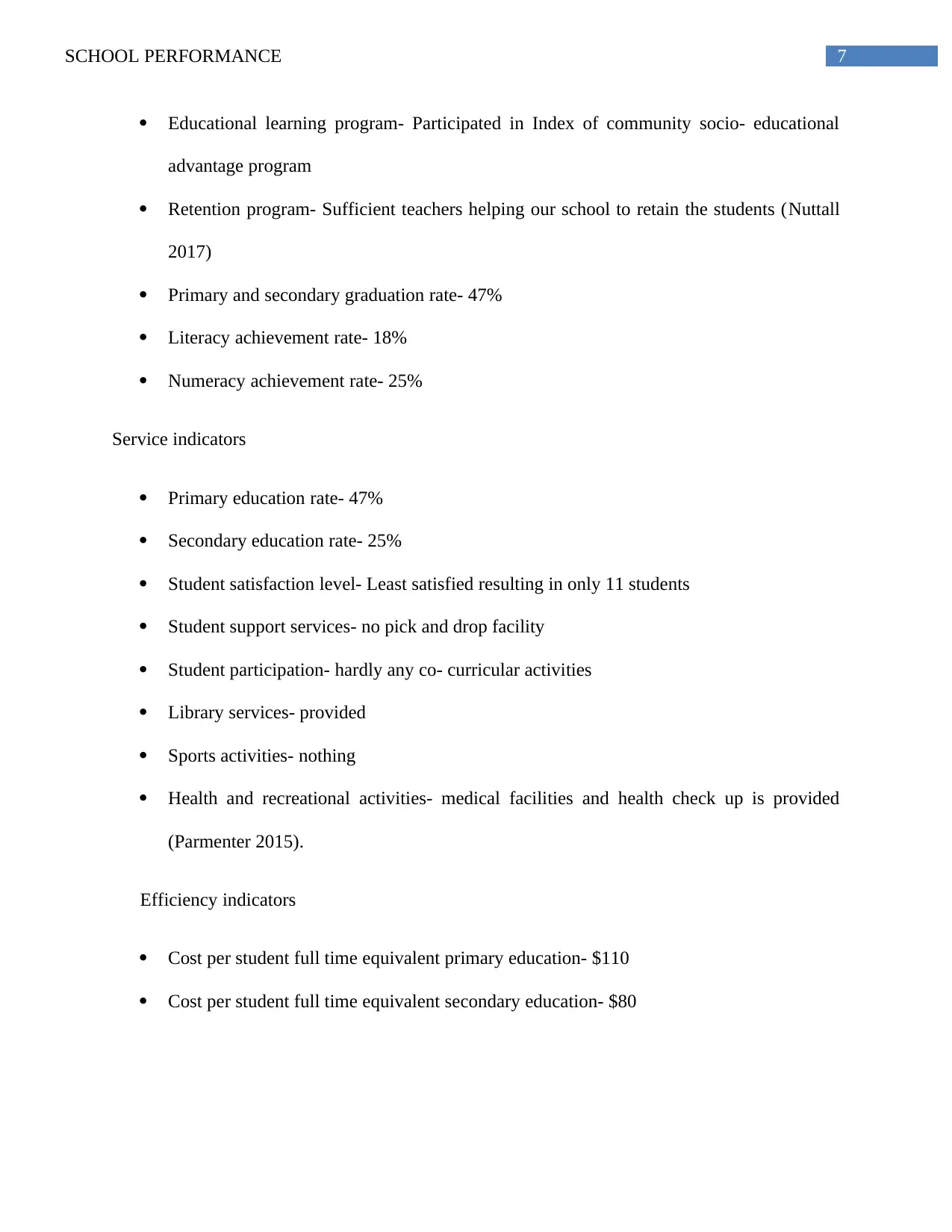
7SCHOOL PERFORMANCE
Educational learning program- Participated in Index of community socio- educational
advantage program
Retention program- Sufficient teachers helping our school to retain the students (Nuttall
2017)
Primary and secondary graduation rate- 47%
Literacy achievement rate- 18%
Numeracy achievement rate- 25%
Service indicators
Primary education rate- 47%
Secondary education rate- 25%
Student satisfaction level- Least satisfied resulting in only 11 students
Student support services- no pick and drop facility
Student participation- hardly any co- curricular activities
Library services- provided
Sports activities- nothing
Health and recreational activities- medical facilities and health check up is provided
(Parmenter 2015).
Efficiency indicators
Cost per student full time equivalent primary education- $110
Cost per student full time equivalent secondary education- $80
Educational learning program- Participated in Index of community socio- educational
advantage program
Retention program- Sufficient teachers helping our school to retain the students (Nuttall
2017)
Primary and secondary graduation rate- 47%
Literacy achievement rate- 18%
Numeracy achievement rate- 25%
Service indicators
Primary education rate- 47%
Secondary education rate- 25%
Student satisfaction level- Least satisfied resulting in only 11 students
Student support services- no pick and drop facility
Student participation- hardly any co- curricular activities
Library services- provided
Sports activities- nothing
Health and recreational activities- medical facilities and health check up is provided
(Parmenter 2015).
Efficiency indicators
Cost per student full time equivalent primary education- $110
Cost per student full time equivalent secondary education- $80
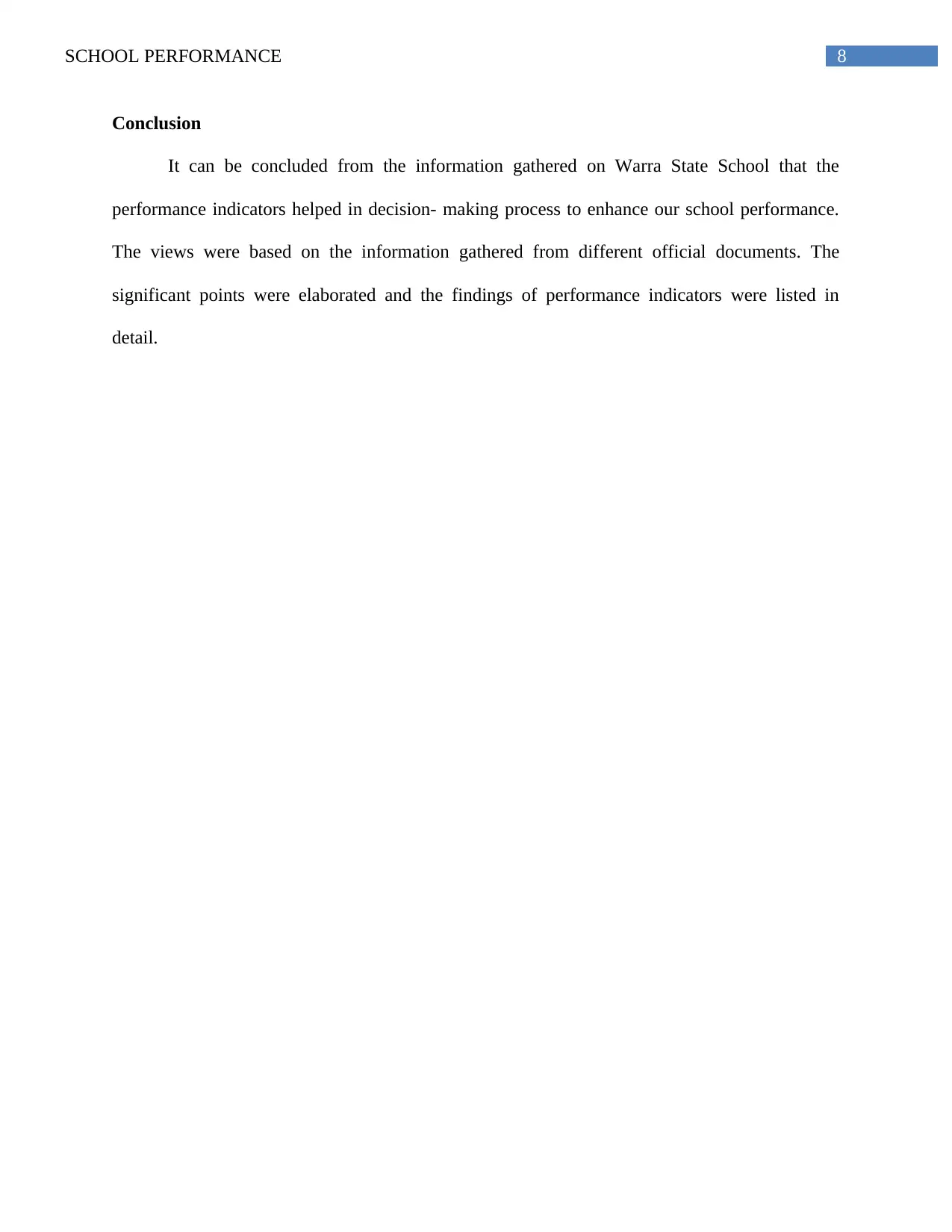
8SCHOOL PERFORMANCE
Conclusion
It can be concluded from the information gathered on Warra State School that the
performance indicators helped in decision- making process to enhance our school performance.
The views were based on the information gathered from different official documents. The
significant points were elaborated and the findings of performance indicators were listed in
detail.
Conclusion
It can be concluded from the information gathered on Warra State School that the
performance indicators helped in decision- making process to enhance our school performance.
The views were based on the information gathered from different official documents. The
significant points were elaborated and the findings of performance indicators were listed in
detail.
⊘ This is a preview!⊘
Do you want full access?
Subscribe today to unlock all pages.

Trusted by 1+ million students worldwide
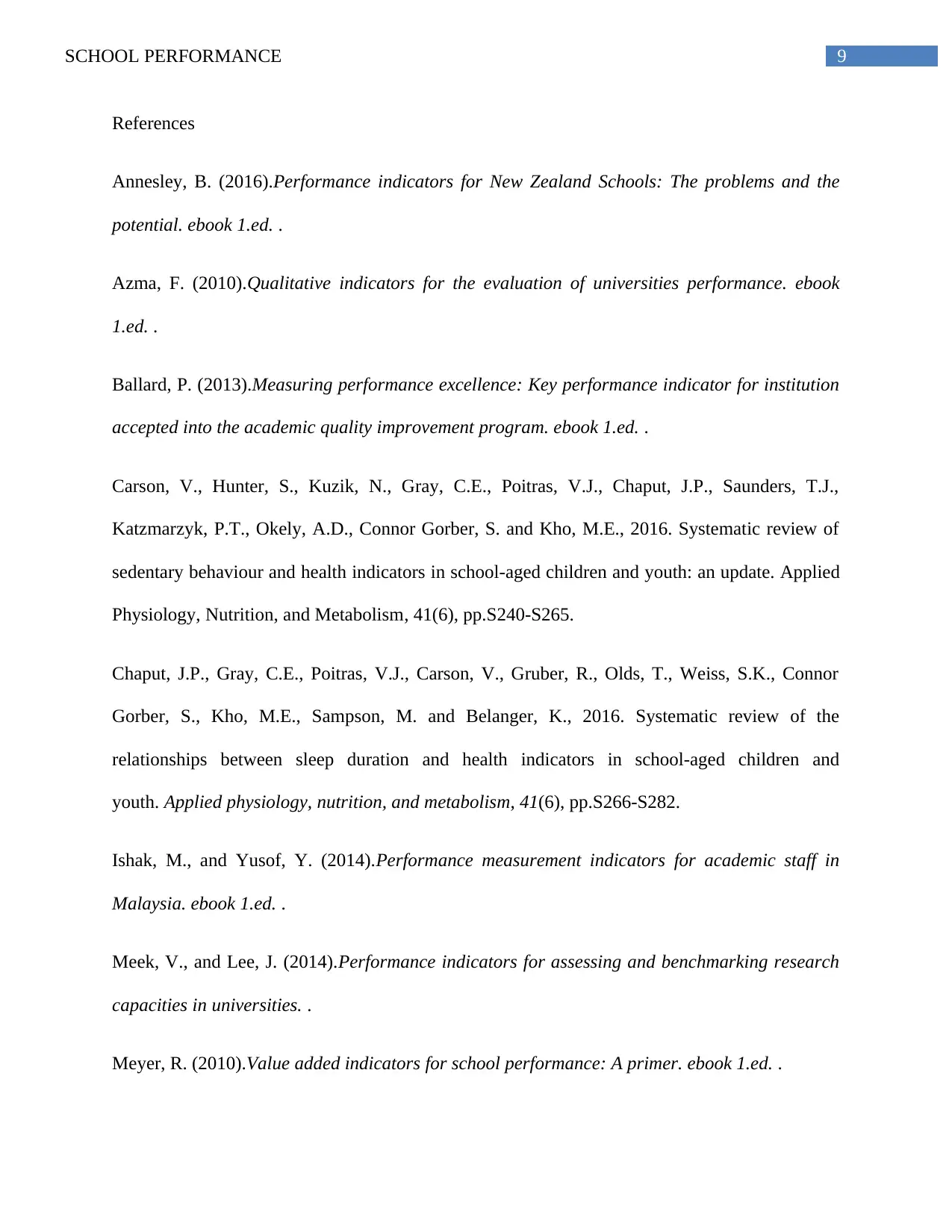
9SCHOOL PERFORMANCE
References
Annesley, B. (2016).Performance indicators for New Zealand Schools: The problems and the
potential. ebook 1.ed. .
Azma, F. (2010).Qualitative indicators for the evaluation of universities performance. ebook
1.ed. .
Ballard, P. (2013).Measuring performance excellence: Key performance indicator for institution
accepted into the academic quality improvement program. ebook 1.ed. .
Carson, V., Hunter, S., Kuzik, N., Gray, C.E., Poitras, V.J., Chaput, J.P., Saunders, T.J.,
Katzmarzyk, P.T., Okely, A.D., Connor Gorber, S. and Kho, M.E., 2016. Systematic review of
sedentary behaviour and health indicators in school-aged children and youth: an update. Applied
Physiology, Nutrition, and Metabolism, 41(6), pp.S240-S265.
Chaput, J.P., Gray, C.E., Poitras, V.J., Carson, V., Gruber, R., Olds, T., Weiss, S.K., Connor
Gorber, S., Kho, M.E., Sampson, M. and Belanger, K., 2016. Systematic review of the
relationships between sleep duration and health indicators in school-aged children and
youth. Applied physiology, nutrition, and metabolism, 41(6), pp.S266-S282.
Ishak, M., and Yusof, Y. (2014).Performance measurement indicators for academic staff in
Malaysia. ebook 1.ed. .
Meek, V., and Lee, J. (2014).Performance indicators for assessing and benchmarking research
capacities in universities. .
Meyer, R. (2010).Value added indicators for school performance: A primer. ebook 1.ed. .
References
Annesley, B. (2016).Performance indicators for New Zealand Schools: The problems and the
potential. ebook 1.ed. .
Azma, F. (2010).Qualitative indicators for the evaluation of universities performance. ebook
1.ed. .
Ballard, P. (2013).Measuring performance excellence: Key performance indicator for institution
accepted into the academic quality improvement program. ebook 1.ed. .
Carson, V., Hunter, S., Kuzik, N., Gray, C.E., Poitras, V.J., Chaput, J.P., Saunders, T.J.,
Katzmarzyk, P.T., Okely, A.D., Connor Gorber, S. and Kho, M.E., 2016. Systematic review of
sedentary behaviour and health indicators in school-aged children and youth: an update. Applied
Physiology, Nutrition, and Metabolism, 41(6), pp.S240-S265.
Chaput, J.P., Gray, C.E., Poitras, V.J., Carson, V., Gruber, R., Olds, T., Weiss, S.K., Connor
Gorber, S., Kho, M.E., Sampson, M. and Belanger, K., 2016. Systematic review of the
relationships between sleep duration and health indicators in school-aged children and
youth. Applied physiology, nutrition, and metabolism, 41(6), pp.S266-S282.
Ishak, M., and Yusof, Y. (2014).Performance measurement indicators for academic staff in
Malaysia. ebook 1.ed. .
Meek, V., and Lee, J. (2014).Performance indicators for assessing and benchmarking research
capacities in universities. .
Meyer, R. (2010).Value added indicators for school performance: A primer. ebook 1.ed. .
Paraphrase This Document
Need a fresh take? Get an instant paraphrase of this document with our AI Paraphraser
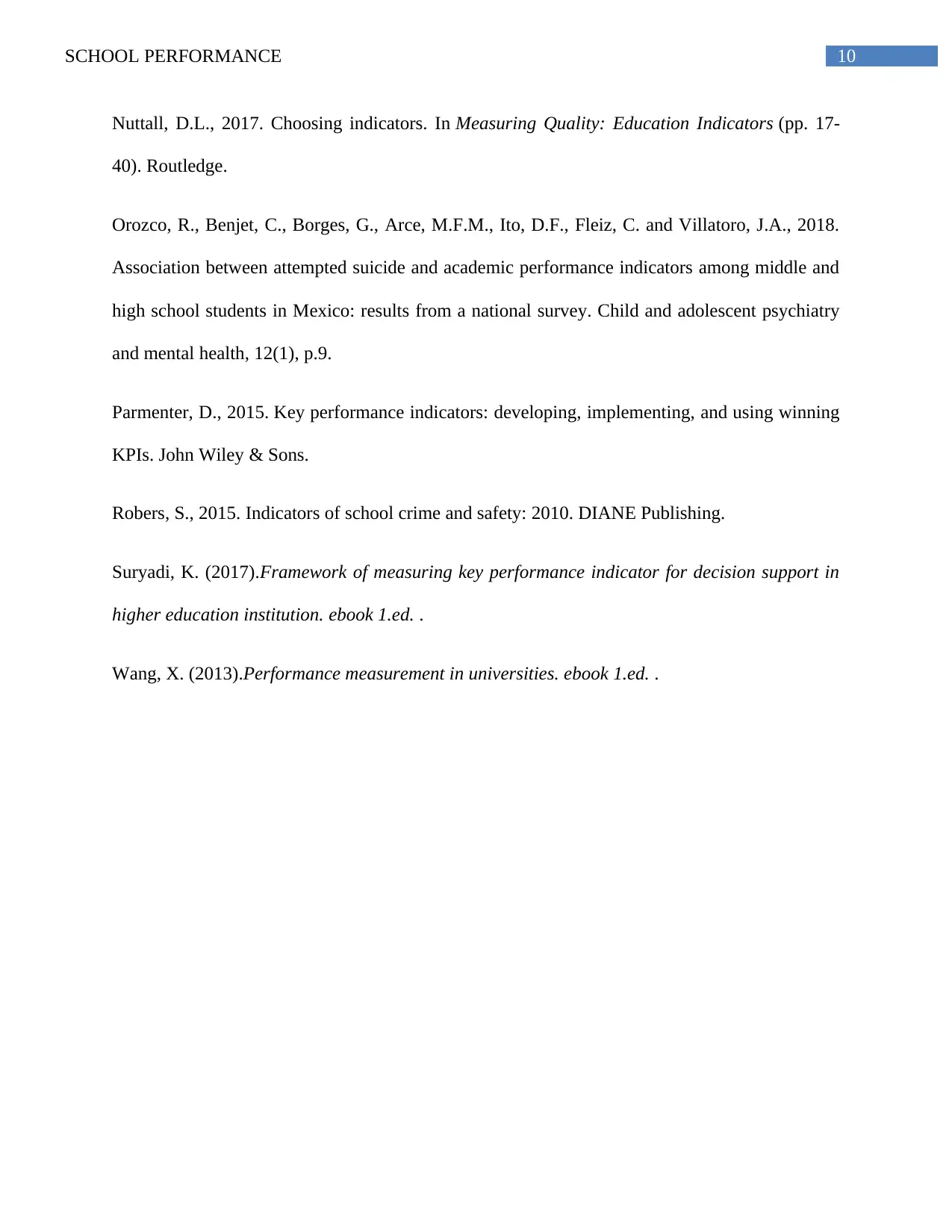
10SCHOOL PERFORMANCE
Nuttall, D.L., 2017. Choosing indicators. In Measuring Quality: Education Indicators (pp. 17-
40). Routledge.
Orozco, R., Benjet, C., Borges, G., Arce, M.F.M., Ito, D.F., Fleiz, C. and Villatoro, J.A., 2018.
Association between attempted suicide and academic performance indicators among middle and
high school students in Mexico: results from a national survey. Child and adolescent psychiatry
and mental health, 12(1), p.9.
Parmenter, D., 2015. Key performance indicators: developing, implementing, and using winning
KPIs. John Wiley & Sons.
Robers, S., 2015. Indicators of school crime and safety: 2010. DIANE Publishing.
Suryadi, K. (2017).Framework of measuring key performance indicator for decision support in
higher education institution. ebook 1.ed. .
Wang, X. (2013).Performance measurement in universities. ebook 1.ed. .
Nuttall, D.L., 2017. Choosing indicators. In Measuring Quality: Education Indicators (pp. 17-
40). Routledge.
Orozco, R., Benjet, C., Borges, G., Arce, M.F.M., Ito, D.F., Fleiz, C. and Villatoro, J.A., 2018.
Association between attempted suicide and academic performance indicators among middle and
high school students in Mexico: results from a national survey. Child and adolescent psychiatry
and mental health, 12(1), p.9.
Parmenter, D., 2015. Key performance indicators: developing, implementing, and using winning
KPIs. John Wiley & Sons.
Robers, S., 2015. Indicators of school crime and safety: 2010. DIANE Publishing.
Suryadi, K. (2017).Framework of measuring key performance indicator for decision support in
higher education institution. ebook 1.ed. .
Wang, X. (2013).Performance measurement in universities. ebook 1.ed. .
1 out of 11
Related Documents
Your All-in-One AI-Powered Toolkit for Academic Success.
+13062052269
info@desklib.com
Available 24*7 on WhatsApp / Email
![[object Object]](/_next/static/media/star-bottom.7253800d.svg)
Unlock your academic potential
Copyright © 2020–2025 A2Z Services. All Rights Reserved. Developed and managed by ZUCOL.




